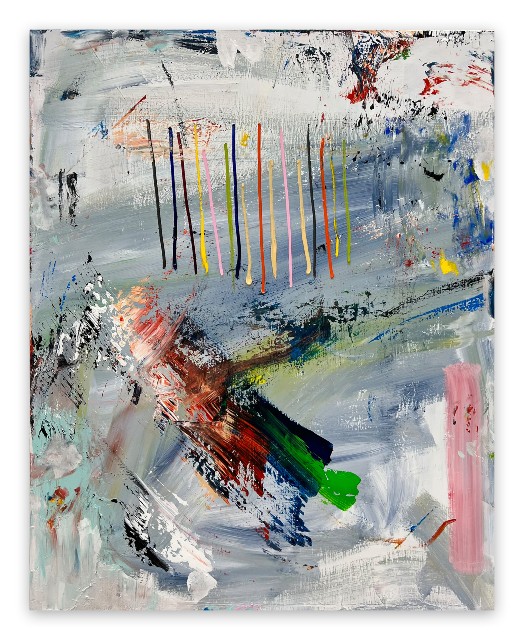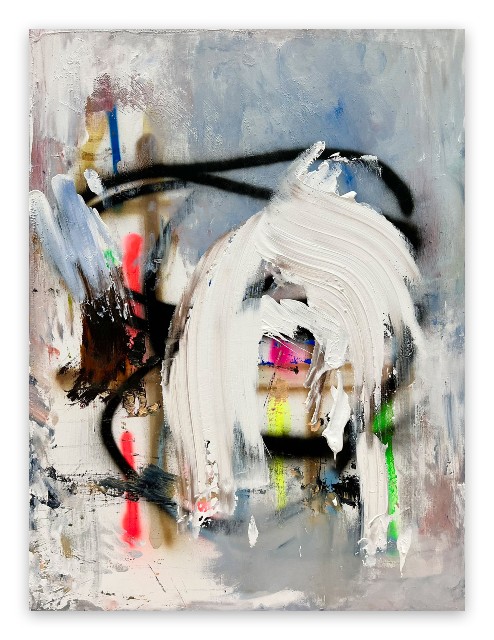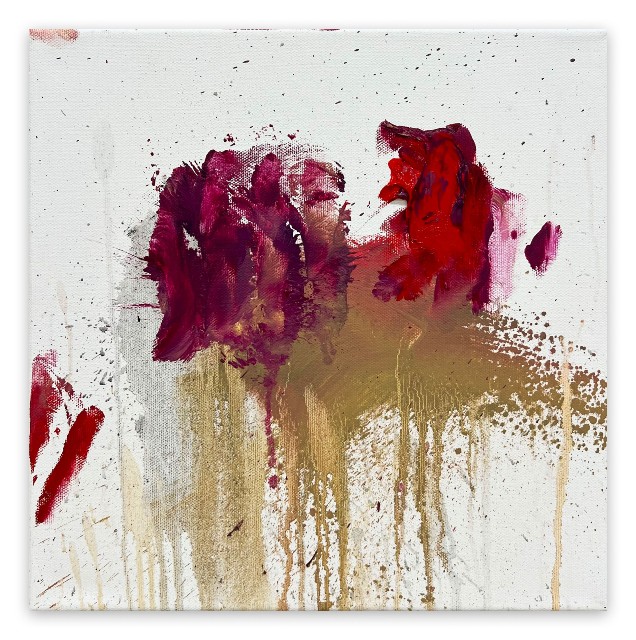
TOMMASO FATTOVICH: ABSTRACTION AND THE PAINTERLY SPARK
A Review of Recent Work (2021-2022)
Richard Jonathan
If ‘drawing’, as Dali said, ‘is the honesty of the artist, because there is no possibility of cheating: it is either good or bad’, then how does one determine the integrity of an abstract painting? And if ‘to draw in order to discover’, as John Berger wrote, ‘is the God-like process, is to find effect and cause’, then where, in abstract painting, might the ‘God-like process’ lie? The fact is, if there are ‘fifty ways to leave your lover’, there are a thousand ways to ‘cheat’ in abstract painting: you can seduce with sensuous color, you can impart seriousness through solemnity; you can be ever-so-clever with optics, you can be fashionably dumb/smart with technique. So how, then, does one distinguish between good abstract painting and bad? I will address this question via a review of Tommaso Fattovich’s recent work (2021-22). As I will try to demonstrate, his work is not only good, but excellent.

Tommaso Fattovich, Worldwide Marine Asset Financial Analyst, 2021
Look at Yoppa (below). How do you respond to it? Do you feel the immediacy of the painting, do you feel its living presence? It is not resigned, it is not submissive; it doesn’t passively await a passing gaze. Instead, staking a claim on one’s attention, it asserts itself: ‘Look. See. I am I. Interact with me’. I look. What do I feel, what do I see? A sense of urgency: the sweeping strokes of the restless ground. A zone of particular excitement: a palimpsest of blackened blue, cobalt green and orange-red oxide, all in a broad diagonal. Calm in the eye of the hurricane: an array of vertical lines, laid out in colors subtle and bold. What else? The grey-blue that lets the canvas breathe, the brush that refuses opacity; the softness of the potter’s pink, its stillness amidst the violence; the range of ways paint is applied, the coherence of the whole. You too might see and feel all this, but may still wonder: What, exactly, makes Yoppa a good painting? It is this: the work offers the beholder not only shapes in space, but a shaping of space. And, as Susanne Langer argues in Feeling and Form, it is just such a creation of a ‘virtual space’ that makes for a good painting, one that ‘presents at once, with complete authority, the primary illusion of a perfectly visible and intelligible space that is self-contained and independent’.

Tommaso Fattovich, Yoppa, 2022
Now look at Passed Me By (below). See how it exhibits the same features we found in Yoppa? Again, we see how Fattovich paints from the solar plexus: the white-blue-grey form against the palimpsest of orange-red oxide conveys a violence of sensation directly to our nervous system, just as what Gilles Deleuze calls the ‘Figure’ in Francis Bacon’s paintings does. Passed Me By, appealing to the body and not merely the eye, is compelling; it is not optical, but carnal. There are no dead spots in it; the entire space is expressive. The painting is good, then, because Fattovich succeeds in animating the inert surface of the canvas. In giving it life, he accomplishes the primary task of the painter: to create a ‘living’, independent space that is in the world but not of it, a ‘virtual space’ that is, as Susanne Langer argues, ‘the primary illusion [the sine qua non] of all plastic art’ that is good.

Tommaso Fattovich, Passed Me By, 2021
Now look at We Can Get Gum (below). Once again we see the vital form, the pull of the receding blue and green, the imperious push of the red. Fattovich lights a match, so to speak, under the ass of his forms, a painterly spark that becomes a regenerating fire, a fire that makes space visible. Indeed, if ‘actual form’ is what an artist works with, what he works for, Susanne Langer asserts, is ‘perceptual form’: that which makes space visible and its continuity sensible. In We Can Get Gum we see how everything pictured serves to define and organize the virtual space, creating an independent locus of the real wherein the painting lives and breathes. I find the force field emanating from this work quite uncanny: I close my eyes and in my mind the image lingers. Despite (or because of?) its violence, it takes me to a place of silence, a place where the white noise of the busy world gives way to a promise of music.

Tommaso Fattovich, We Can Get Gum, 2022
Now look at Blondie (below). Do you see how the artist leaves no doubt that he is the protagonist of his painting? That the surface is an arena in which he confronts—like a boxer, a bullfighter, a wrestler—whatever the work-in-progress throws at him? Fattovich’s is a form of action painting in which the painterly gesture relentlessly pursues the spark that will ignite the canvas and bring the work to life. There are no dead conventions here, nor any decorative clichés; instead, the painting crashes into our lazy ways of looking and, bearing its significance within itself, imposes it on the beholder. The textured white impasto, the looping black lines; the bright fluorescent verticals, the scraped and smudged ground: every gesture concurs to create a virtual space in which forms and fields reflect emotion. In the course of Blondie’s coming into being, Fattovich attained a state of grace. How else to explain that wherever the eye-brain connection intersected the hand-heart one, his every gesture became composition and form took on feeling, bringing the work to life?

Tommaso Fattovich, Blondie, 2021
Now consider the three paintings below. If you’re feeling nostalgic for the figurative, you might see Flowers of Evil in Green Mountain Beauties’ cadmium red and green gold, blackened magenta and silver grey; a Rider on the Storm in Bloom’s frosty blue, and in Gulch’s orange-red oxide, stalactites. If you have a Zen sensibility, you might find in the paintings the aesthetic of the incomplete circle, the ethic of stillness as active calm, or the principle of less-is-more. Now note this: If, in the first four paintings we studied, form took a back seat to the play of forces, here, in these three, both form and force seem to be surrendering to entropy. ‘This is the end, beautiful friend’, they seem to say, ‘the end of our elaborate plans, the end of everything that stands’. What makes these paintings so eloquent, what is the ‘God-like process’ that makes them speak? We’ve come full circle: in each painting, the artist has succeeded in creating a virtual space, independent and otherworldly, a space that accounts for the work’s ability to speak. ‘The point of painting’, Francis Bacon said, ‘is to deepen the mystery’. In these paintings, Tommaso Fattovich, through his unremitting pursuit of the painterly spark, has achieved just that. In the eternal ‘now’ of consumer culture his paintings give us pause; if we have eyes to see, they enable us to reconnect with what is most authentic in us.

Tommaso Fattovich, Green Mountain Beauties, 2021

Tommaso Fattovich, Bloom, 2021

Tommaso Fattovich, Gulch, 2021
MORE WORKS BY TOMMASO FATTOVICH
MARA, MARIETTA: A LOVE STORY IN 77 BEDROOMS
A literary novel by Richard Jonathan
WHY READ ‘MARA, MARIETTA’
Available from AMAZON (paper | ebook) & iBOOKS, GOOGLE PLAY, KOBO & NOOK (see LINKS below)
By Richard Jonathan | © Mara Marietta Culture Blog, 2022 | All rights reserved


Comments
1 thought on “Tommaso Fattovich: Abstraction and the Painterly Spark”
This blog post remains the best treatise on abstract painting I’ve seen in recent years. Bravo!